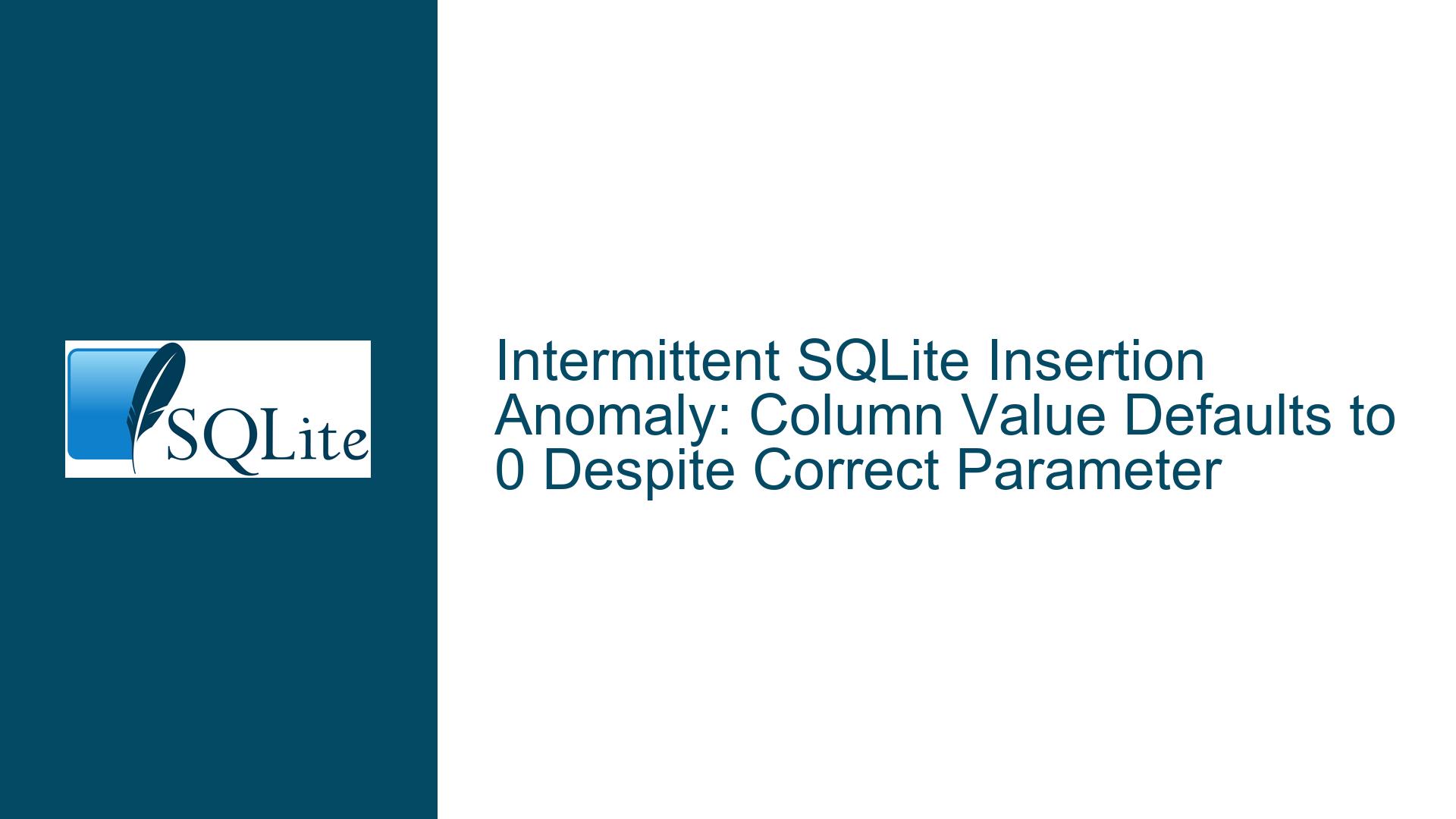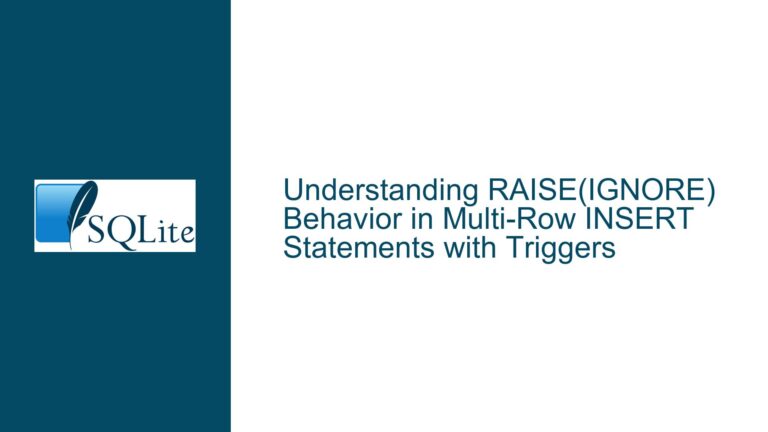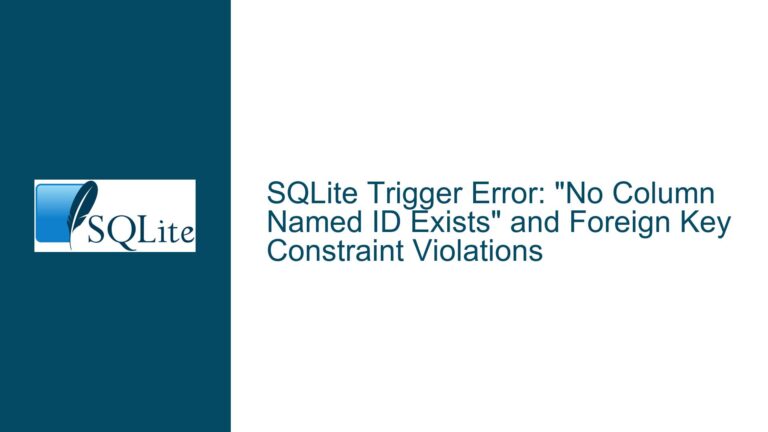Intermittent SQLite Insertion Anomaly: Column Value Defaults to 0 Despite Correct Parameter
Issue Overview: Column Value Mismatch During Insertion Without Errors
A developer encounters an intermittent issue where a specific column (SYSTEM_K2_ID) in an SQLite table defaults to 0 after an INSERT operation, despite the SQL command explicitly setting it to 35. The problem occurs without errors, making it difficult to detect. The application uses the System.Data.SQLite C# library (v1.0.117) with SQLite engine v3.31.0. The column is intended to act as a secondary key, but foreign key constraints are not enforced in the schema. The issue manifests rarely, often reported by users, and is challenging to reproduce. Key observations include:
- No Explicit Error Handling: The code does not check for specific SQLite error codes (e.g.,
SQLITE_BUSY), nor does it enforce foreign key constraints. - Concurrency and Threading: The application uses a semaphore to manage multi-threaded database access, but the implementation may not cover all edge cases.
- Parameter Binding Practices: The SQL command uses named parameters, but the C# code’s parameter-binding logic may not align with the query’s structure.
- Schema Design Flaws: The absence of foreign key declarations allows invalid values (e.g.,
0) to be inserted without validation.
This issue undermines data integrity and highlights broader risks in trusting unvalidated inserts. The root cause likely involves a combination of parameter mismatches, concurrency edge cases, and schema design oversights.
Potential Causes: Parameter Mismatches, Concurrency, and Schema Validation Gaps
1. Parameter Binding Mismatches
- Named vs. Positional Parameter Discrepancies: If the SQL query uses named parameters (e.g.,
@SYSTEM_K2_ID) but the C# code binds parameters without including the@symbol, SQLite will treat the parameter as unbound. Unbound parameters default to0for integer columns. - Case Sensitivity: SQLite parameters are case-sensitive. A parameter named
@system_k2_idin the query will not match a dictionary keySYSTEM_K2_ID. - Data Type Coercion: Implicit type conversions (e.g., inserting a string
"35"into an integer column) may fail silently, defaulting to0.
2. Concurrency and Locking Conflicts
- Unhandled
SQLITE_BUSYErrors: If the database is locked by another thread or process, SQLite returnsSQLITE_BUSY. The current code does not retry or handle this error, leading to incomplete writes. - Semaphore Gaps: While a semaphore (
SecureSqlite) limits concurrent access, it may not cover all code paths (e.g., error-handling branches where the semaphore is released prematurely).
3. Schema and Validation Deficiencies
- Missing Foreign Key Constraints: Without
FOREIGN KEYdeclarations, SQLite does not validate whetherSYSTEM_K2_IDexists in the referenced table, allowing invalid values. - Trigger Interference: A trigger on the
GRAPHEtable could resetSYSTEM_K2_IDto0after insertion. - Column Order Mismatches: If the
INSERTstatement’s column order does not match the table schema, values may be assigned to the wrong columns.
4. SQLite Engine and Library Quirks
- Legacy SQLite Version (3.31.0): Older SQLite versions may have unresolved bugs related to concurrency or parameter binding.
Prepare()Method Omission: While optional, callingSQLiteCommand.Prepare()after parameter binding can precompile the query and surface binding errors earlier.
Troubleshooting and Solutions: Ensuring Robust Inserts and Data Integrity
Step 1: Validate Parameter Binding
- Audit Parameter Names: Ensure dictionary keys in
argsmatch the parameter names in the SQL query exactly (e.g.,@SYSTEM_K2_IDvs.SYSTEM_K2_ID). - Use Strongly-Typed Parameters:
cmd.Parameters.Add(new SQLiteParameter("@SYSTEM_K2_ID", DbType.Int32) { Value = 35 }); - Test with Hardcoded Values: Temporarily replace parameterized values with literals to isolate binding issues:
INSERT INTO GRAPHE(...) VALUES(0, 0, 35, ...); - Log Parameter Values: Extend
DEBUG_BDD.SetCommandLineSQLiteto log the actual values bound to parameters.
Step 2: Enforce Schema Validation
- Enable Foreign Keys:
using (var cmd = new SQLiteCommand("PRAGMA foreign_keys = ON;", con)) { cmd.ExecuteNonQuery(); } - Add Foreign Key Constraints (if feasible):
CREATE TABLE GRAPHE ( ..., SYSTEM_K2_ID INTEGER REFERENCES OtherTable(ID), ... ); - Check for Triggers:
SELECT sql FROM sqlite_master WHERE type = 'trigger' AND tbl_name = 'GRAPHE';
Step 3: Handle Concurrency and Locking
- Implement
SQLITE_BUSYRetries:int retries = 3; while (retries-- > 0) { try { numberOfRowsAffected = cmd.ExecuteNonQuery(); break; } catch (SQLiteException ex) when (ex.ResultCode == SQLiteErrorCode.Busy) { Thread.Sleep(100); } } - Audit Semaphore Scope: Ensure
SecureSqliteis acquired and released in all code paths (e.g.,finallyblocks).
Step 4: Upgrade and Optimize SQLite
- Update SQLite Engine: Use a newer
System.Data.SQLitepackage (e.g., 1.0.118+) with SQLite 3.40.0+ for bug fixes and performance improvements. - Enable Write-Ahead Logging (WAL):
Dtbase = "Data Source=" + BaseSqlite + ";Version=3;PRAGMA journal_mode=WAL;";
Step 5: Strengthen Error Handling and Logging
- Capture Detailed Errors:
catch (SQLiteException ex) { WriteInLogError(..., ex.ErrorCode, ex.Message); } - Validate
ExecuteNonQueryResults:if (numberOfRowsAffected != 1) { throw new InvalidOperationException("Insertion affected unexpected rows."); }
Step 6: Review Transaction Management
- Wrap Inserts in Explicit Transactions:
using (var transaction = con.BeginTransaction()) { using (var cmd = new SQLiteCommand(query, con, transaction)) { // Execute command } transaction.Commit(); }
Step 7: Test with Prepared Statements
- Call
Prepare()After Binding Parameters:foreach (var pair in args) { cmd.Parameters.AddWithValue(pair.Key, pair.Value); } cmd.Prepare(); // Surface binding errors during preparation
By systematically addressing parameter binding, concurrency, schema validation, and error handling, this issue can be resolved. Implementing foreign keys and upgrading SQLite will further fortify data integrity.






